Bob Olthoff and his MGA Twin Cam Revisited: Part 1
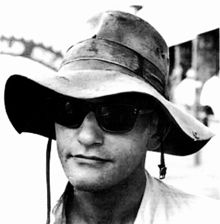
 Robert Jacob ‘Bob’ Olthoff (1937–2004) is a name that often features, if only briefly, in any history of MG. Both Bob and his car deserve more than a passing mention, not so much because of the results he obtained racing his MGA Twin Cam, but because his car was the only standard bodied Twin Cam that competed in period in an FIA International race with the 1762cc, or Le Mans, Twin Cam engine.
Robert Jacob ‘Bob’ Olthoff (1937–2004) is a name that often features, if only briefly, in any history of MG. Both Bob and his car deserve more than a passing mention, not so much because of the results he obtained racing his MGA Twin Cam, but because his car was the only standard bodied Twin Cam that competed in period in an FIA International race with the 1762cc, or Le Mans, Twin Cam engine.
I researched Bob, Bob’s car and the history of the 1762cc Twin Cam engine with a view to building a replica of Bob’s car. This threw up as many questions as answers particularly about the relationship between MG and Bob, their approach to the 1961 season and Bob’s challenges in trying to break into the UK motor racing scene in the early 1960s.
However it was Bob’s ‘Phoenix Park’ letter in the 18 August 1961 edition of Autosport which led me to take another look at his story and, in particular, those parts of it which seemed difficult to take at face value. More of that letter and the circumstances surrounding it later.
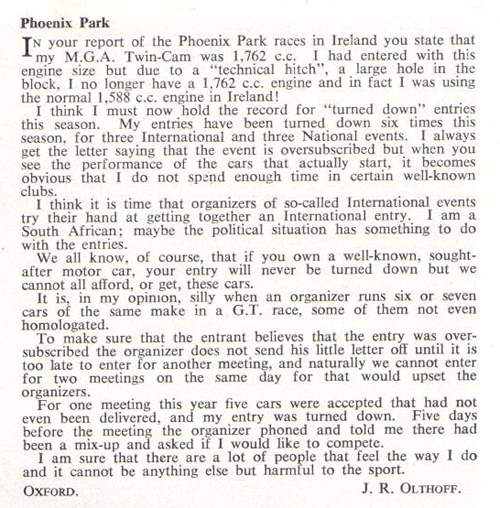
Bob’s story appeared in the March 1962 edition of Safety Fast!, his car having been featured on the cover of the January edition.
A road test of Bob’s car by Paddy McNally was published in the 9 March 1962 Autosport. The March 1962 edition of Motoring, the BMC house magazine also ran an article about Bob and his MGA.
Bob’s story has essentially always been ‘as told by Bob’ and needs to be reviewed in the context of his situation in March 1962. This article is both a précis of that story and a commentary on certain aspects of it based not only Bob’s story, as he told it, but also on other information that has come to light.
Bob campaigned with his MGA Twin Cam (YDH5/929) in South Africa, the UK, Ireland and Germany from 1959 to 1962. In 1959 Bob took delivery of the first Twin Cam to be assembled in South Africa. He raced it in South Africa with some success. In March 1960, aged 22 and to further his racing career, he flew to the UK with his new wife but without his car.
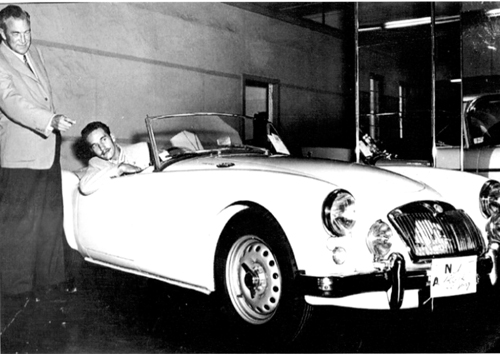
In the UK he got a job with MG in Abingdon, sent for his Twin Cam from South Africa and competed in it with, necessarily unofficial, factory support in 1960, 1961 and 1962 with moderate success.
Bob was the MG reserve driver and mechanic at Sebring in 1961 and actually drove there in 1962 as well as being Ted Lund’s co-driver in the special bodied MGA, SRX 210, at Le Mans in 1961. Bob was a talented driver and his coming third in the 1961 Autosport Championship was an achievement, nevertheless this was probably the least successful period of his racing career. It was however key to creating motor sport opportunities for him in the years ahead.
Bob’s March 1962 story necessarily ends at that point, the conclusion being that he had finished racing his MGA Twin Cam and that he was looking beyond MG and BMC for a works drive. He also sought to explain why his car had been competitive in 1961 when essentially no other MGA Twin Cam had been. A few subsequent articles, mainly written in conjunction with him, appeared 20 or more years later.
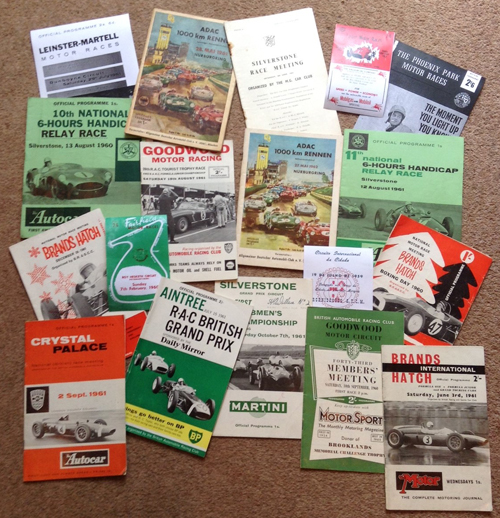
The question as to what capacity engine Bob had been running in 1961 was highlighted by the Autosport letter yet, surprisingly, there was no mention of engine capacity in any of the March 1962 articles, nor of any holed block.
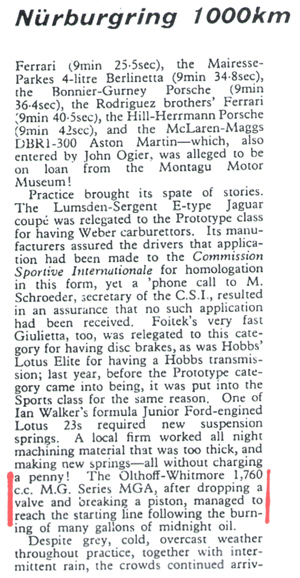 March 1962 and Beyond
March 1962 and Beyond
Bob’s exploits with his MGA did not end in March 1962. He competed in the May 1962 Nurburgring 1000km race. He had all sorts of dramas in practice, and a major engine failure meant he did not finish. As in 1961 his co-driver was John Whitmore. He entered and raced in the Sports and GT Prototype category at 1762cc.
Bob last raced in his car in July 1962 at Snetterton, entered at 1588cc, and used it as everyday transport until September 1963.
To Sell or Not to Sell
After the 1962 Nurburgring 1000km race Bob agreed to sell his car to Mike Holt, who set out what happened in a handwritten letter in 1984. Mike learnt from Richard Ide, a contemporary MGA driver, that Bob’s car was for sale but it seems that Mike was not made aware that ownership of the car, being a personal import, could not be transferred until May 1963.
Bob took Mike for an alarming test drive around Oxford, visited Syd Enever, looked at the prototype MGB and shook hands at £1,100, with delivery set for some weeks later. Bob subsequently told Mike that he had agreed to lend the car to Paddy Hopkirk to compete in a race at Phoenix Park in Dublin on 14 July 1962. In fact the car was never entered for the Dublin meeting. The story continues, the car was seemingly shipped back to Liverpool from Ireland and a mechanic sent from the factory to collect it. The mechanic apparently mistook the radiator header tank for the oil filler and there was another failed engine!
Whatever really happened, the sale fell through. Interestingly, when Bob sold the car to Roland Greenwood in 1963 for £650 there was a racing head with oil residue in the water passages and Roland tells the story of degreasing it in a bath at an Officers Mess in Germany. The engine failure at the 1962 Nurburgring 1000km may well have left Bob with an oiled-up head.
There is a photograph of Bob’s car competing at Silverstone, driven by Jack Paterson, on 14 July 1962, the same day as it was supposedly in Dublin.
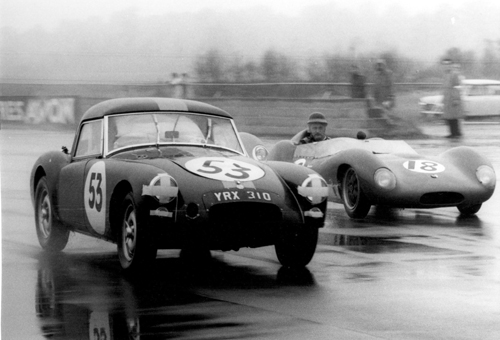
So why the Irish yarn? Perhaps Bob recognised he could not complete the sale because of the import restriction, and wanted to present this as ‘force majeure’ rather than going back on his word. His relationships in 1962 with his motor racing peers may have dictated the embellishment.
Back to the Log Book
Having imported his MGA, Bob registered it as YRX 310 on 27 August 1960 and a duplicate Log Book was issued to him on 14 September 1961. The duplicate sale restriction was added in January 1962. The 310 number may have a significance in the 1762cc story but, again, more of that later.
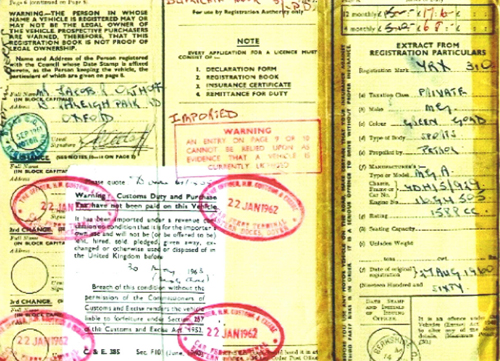
Bob raced the car, and used it as everyday transport, under its South African registration of TK13320 up until 16 September 1961, over a year after he should have changed it to YRX 310. Quite why he did this will never be known.
Why Bob’s Car and Why an HTP?
I wanted to get an FIA Historical Technical Passport or HTP for a standard bodied MGA Twin Cam at 1762cc rather than the homologated capacity of 1588cc. I was aware others had tried and failed. I identified that replicating Bob’s car was a possible route to doing this. His car also had fibreglass front and rear wings which were homologated for the MGA 1600 MkII but not the Twin Cam.
An HTP validates the car’s specification, whether an original car or a replica, as being how it ran in period in an FIA International Race. In researching the specification of Bob’s car, I ended up researching both Bob himself and his time with MG from 1960 to 1963.
To get an HTP at 1762cc I had to prove that Bob’s car ran in an appropriate race in period at the 1762cc capacity and replicate it exactly save for the safety requirements imposed by the FIA. The rules for obtaining an HTP are set out in the current Appendix K of the International Sporting Code, or ISC, relating to historic motor sport. This document runs to over 80 pages! Appendix K is quite clear when it says replicating a specific car has to be done ‘as entered’, rather than ‘as ran’. Consequently any infringement of the rules in period will not get sanctified later by the subsequent issue of an HTP.
Bob’s car had run in three FIA International, and thus HTP qualifying, races, namely the 1961 and 1962 Nurburgring 1000km races and the 1961 Goodwood Tourist Trophy. In both of the 1961 races Bob entered in the GTS, or Class 3, category of the then current Appendix J of the ISC. This required the car to run at the homologated capacity of 1588cc although, paradoxically, it did allow the fibreglass wings. Regardless of the capacity at which he actually ran in 1961 an HTP at 1588cc only would be attainable in respect of that year. Period E runs up until the end of 1961 and thereafter it becomes Period F. Different periods impose different safety requirement, for example, a Period F car requires a Roll Over Protection System and a foam filled fuel tank whereas Period E does not.
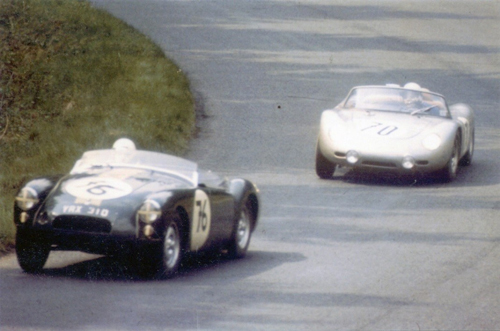
This only left the 1962 Nurburgring 1000km race which Bob had entered in the Sports and GT Prototype, or Class 4, category. That category would have allowed an entry at 1762cc, unlike the Period E races, so now it was only remained to prove his car had entered and run at 1762cc.
After an initially fruitless search I tracked down an Autocar report of the 1962 Nurburgring race which referred to Bob running at 1760cc. However Appendix K states in period reporting requires two such articles in order to validate a specification. ADAC organised the Nurburgring 1000km races and their programmes delineate only the class and not the capacity. ADAC were adamant they kept no archives but since the Germans have always been meticulous record keepers I persisted. My breakthrough came when a German motoring journalist came to know of my quest through a mutual friend. He managed to convince ADAC that their statement that they did not keep records was, at least, suspect and was allowed a trawl of their basement, which threw up the class entry sheet for the 1962 race showing an entry for a 1762cc MGA Twin Cam. Bob’s car was the only MG in the class and the only MG which participated in the race.
I had the evidence I needed, now what to do with it – to be continued.
Many thanks to Andy Knott, Editor Safety Fast!, and author, Edward Vandyk, for their permission to reproduce this article.

